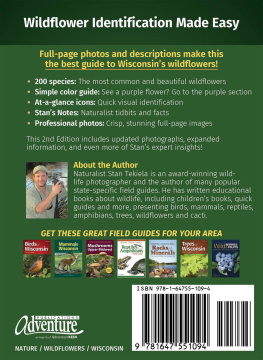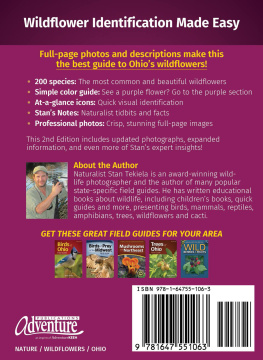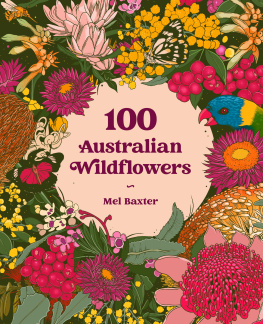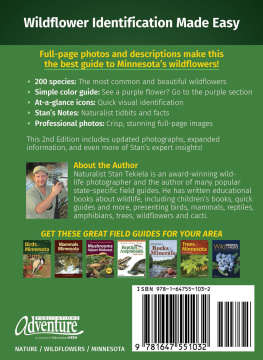
Penstemon baccharifolius growing on exposed limestone cliffs along the Pecos River in Val Verde County.

A field of two of the most common springtime roadside flowers, Lupinus texensis and Castilleja indivisa, in Llano County.
WILDFLOWERS
of TEXAS
Michael Eason
TIMBER PRESS FIELD GUIDE

Physaria fendleri and Stenandrium barbatum along a limestone ridge in Brewster Country.
Dedicated to my parents, Jack and Betty Eason. Thank you for taking me camping and introducing me to the wonders of the natural world.
CONTENTS

Agave lechuguilla with blooming Castilleja rigida.
ACKNOWLEDGMENTS
The completion of this work would not have been possible without the assistance and generosity of many people.
Many of the photographs were taken on private property throughout Texas and beyond. I am grateful to landowners who permitted me access to their properties. Their dedication to the conservation and protection of their lands is rarely acknowledged, but without these stewards, much of our natural history would be lost. While it would be impossible to list all the property owners, ranch managers, and stewards who allowed access, I do thank each and every one of them for their generosity and openness in allowing me and others access to their lands to document and research the flora of Texas.
Thank you to Duane T. Corley, who allowed access to his property in Montgomery County as well his ranch in northern Mexico. I was able to photograph many aquatic and wetland species in Montgomery County with ease. The ranch in northern Mexico allowed me to photograph many species which are uncommon or rare in Texas, including Bouchea linifolia, Gomphrena haageana, and Haplophyton crooksii.
Thanks to Hardy Jackson, his mother, Nora Nell Jackson, and his late father, Richard Jackson, for wonderful meals, conversation, lodging, and access to their property in Starr County, while photographing plants in the Lower Rio Grande Valley. I first met the Jackson family in 2008 and have remained friends with them through the years. I am especially grateful for Hardys time chauffeuring me and my dog, Roemer, to various ranches in Starr County, and for allowing Roemer to chase deer and rabbits and play with Rosie. Roemer is forever thankful.
Other land owners I would like to thank include Steve Bentsen (Starr County), Gary and Clare Freeman (Jeff Davis County), Lloyd and Emma Hampton (Lampasas County), Harry Miller (Presidio County), Elizabeth Rogers (Brewster County), Hiram and Liz Sibley (Pecos County), and Edie Stewart (Montgomery and Brooks Counties).
I would like to give my appreciation to the folks at The Nature Conservancy. Many species photographed in the Davis Mountains were taken on their Davis Mountain Preserve. Additional plants were photographed at Dolan Falls, Independence Creek, and Southmost Preserves.
I would like to thank several people who spent time with me in the field and from whom I learned quite a bit when first starting a career in botany: Burr Williams, previously with the Sibley Nature Center; Wynn Anderson, now retired from the University of Texas at El Paso; Patty Manning, formerly with Sul Ross State University; and Ad and Gertrud Konings, authors of Cacti of Texas in Their Natural Habitat.
Several people graciously contributed images for this book. Thank you, Layla Dishman, Sonnia Fajardo Hill, and Rosanna Ohlsson-Salmon. Numerous species would not have been included without their contributions. Additionally, I would like to thank Matt Buckingham and Shirley Powell for last-minute image substitutions and needs as well as landscape images.
Thank you to Theodore and Nancy Haywood, whose support and understanding allowed this book to be completed. Thanks to Martin Simonton for photographing Helianthus grosseserratus, saving me a 20-hour round trip to East Texas; for assistance in finding Nymphaea ampla; and for numerous trips throughout Texas and northern Mexico to seek out plants.
Special thanks to Tonya Beard for editing, proofreading (several times), and suggesting changes in format and content as well as for help in resolving the excruciating dilemma of selecting color groups. In addition, I would like to thank Tonya for her patience, especially during the final few months of this project.
Thank you to Turner Collins of Evangel University for properly identifying the two questionable species of Orobanche, and to Michael Powell for his assistance in the herbarium at Sul Ross State University.
I would like to acknowledge several people who read over various documents and gave their input and suggested changes. Martin Terry, Martin Simonton, and Dallas Baxter, thank you for taking time to look over the species descriptions and other documents, and for your suggestions and encouragement throughout the process. Thanks to Nathan Carroll, who developed a database of the flora of Texas in 2007 and supplied me with various species lists as I began my research. Lori Gola, thank you for your patience while taking my portrait that sweltering day in Central Texas; I am sure I was a difficult subject.
At Timber Press I would like to thank Juree Sondker, with whom I first worked on this project. I was a bit apprehensive about undertaking such a project on my own and little did I know at the time how much work would actually be involved. Thanks also to Andrew Beckman, whose patience was tested during the final stages of this work after I went well beyond my deadline. Thanks to Sarah Milhollin, who reviewed thousands of images, some twice. Additionally, I would like to thank Linda Willms and Julie Talbot for editing the manuscript, culling nearly 15,000 words and catching many mistakes my bleary eyes could not.
Thank you, Steve Muzos, professor at Austin Community College. It was in your field biology class that my interest in plants was reignited. I remember having to create our own dichotomous keys, a skill I still use to this day when performing vegetation surveys. Other professors who encouraged me include Robert Koehn, formerly of Texas State University; and Martin Terry and James Zech, both of Sul Ross State University and who both advised me to pursue this project. And I would like to thank Flo Oxley. I am forever grateful for her support and guidance during my employment at the Lady Bird Johnson Wildflower Center, as well as her confidence in me while working with her and in undertaking this task.
I would also like to thank the numerous people whose passion for plants led them down a similar path and who have published field guides. I believe the first field guide my family purchased outside of the Golden Guide series was Roadside Wildflowers of Texas by Howard Irwin and Mary Motz Wills. This book led to numerous local and statewide field guides covering both the flora and fauna of Texas. I still own and treasure each field guide Ive ever purchased, even those early Golden Guides.
Next page









